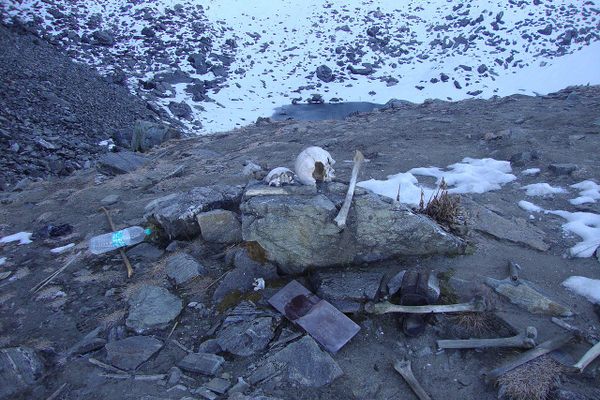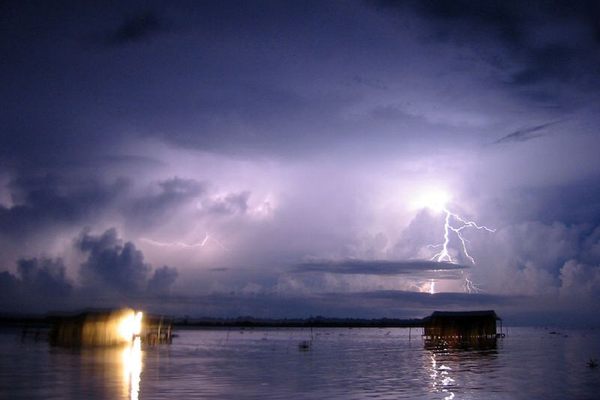Hail No: An account of the worlds biggest, deadliest hailstorms
.png)
In 1942 a British forest guard in Roopkund, India made an alarming discovery. Some 16,000 feet above sea level, at the bottom of a small valley, was a frozen lake absolutely full of skeletons. That summer, ice melt revealed even more skeletal remains, floating in the water and lying haphazardly around the lake’s edges. Something horrible had happened here.
A National Geographic team set out to examine the bones in 2004. Besides dating the remains to around 850 AD, the team realized that everyone at the “Skeleton Lake” had died from blows to the head and shoulders caused by “blunt, round objects about the size of cricket balls.”
This eventually led the team to one conclusion: In 850 AD this group of 200 some travelers was crossing this valley when they were caught in a sudden and severe hailstorm. An ancient folk song of the area describes a goddess so enraged at outsiders who defiled her mountain sanctuary that she rained death upon them with ice stones “as hard as iron.”

Hail killed every last one of them.
Death by hail, though rare (one is much more likely to be struck by lightning for example) is no anomoly. Below are some accounts of the deadliest, costliest and just plain biggest hailstorms to ever be recorded.
.jpg)
The last known hail fatality in the US happened in 2000 in Fort Worth, Texas when 19 year old Juan Oseguera was hit in the head with softball sized hail. Hail of this size falls at around 100mph, and weighing as much as a pound, the force is the equivalent someone throwing a masonry brick at your head, which is more than enough force to kill you.
Up until recently the largest hailstone on record, officially recorded by the National Climate Extremes Committee, fell in Aurora, Nebraska in 2003, and is seven inches in diameter – a tad smaller than the size of a bowling ball. Locals who saw the hailstone grabbed it and stuck it in a freezer long enough for it to be officially measured. The size however is misleading, as the hailstone may have lost as much as 40 percent of its mass when it collided with the house gutter and also may have melted a bit before it was recovered. The title of heaviest hail on US record belonged to a hailstone the fell in Coffeeville, Kansas in 1970 and weighed some 1.67 pounds.

Both of these records were recently smashed when on July 23, 2010 a hailstone 8 inches in diameter and 1.93 pounds fell in Vivian, South Dakota. (Both this and the Aurora hailstones are preserved at the National Center for Atmospheric Research in Boulder, Colorado.)
But hail need not be huge to kill, it only has to be big enough.
In 1979 an infant was struck in the head and killed by a piece of golf ball sized hai in Fort Collins, Colorado while his mother clutched him running for cover.
Going back in the records, on May 13, 1939, near Lubbock, Texas a 39-year-old farmer died of injuries received when he was caught in an open field during a severe hailstorm (one of the three hail related deaths officially authenticated by the National Weather Service), and a fourteen year old boy was killed by hail while working in a field in Laredo, Texas in 1928.
Hail can also cause collateral death, as in the 1986 case of a plane near Addison Airport in Dallas Texas. Hail broke the windshield of a small plane, it crashed, and the pilot was killed.

Going way back in the records, perhaps the largest death toll in the United States caused by a single hailstorm was reported by the South Carolina Gazette, where eight people were said to have been killed by hail along the Wateree River in 1784. From the Gazette
“On the eighth of May last, a most extraordinary shower of hail, attended with thunder and lightning, fell in this district, and along the banks of the Wateree; the hail stones or rather pieces of ice, measured about 9 inches in circumference; it killed several people, a great number of sheep, lambs, geese, and the feathered inhabitants of the woods”
Injuries from hail are naturally much more common than death, and those caught in a 1995 Fort Worth, Texas* described the experience of being caught in a hailstorm. “I started running and got hit in the head. Blood was everywhere,” said one, and another reported being “hit so hard I thought I was going to pass out.”
(*Texas and Colorado are part of the “Hail Belt,” which means they deal with many of the worst hailstorms in the United States.)
In Orient, Iowa, in August 1980, ferris wheel riders at an amusement park were left extremely unamused when a storm cut power the ride and they were left stuck under a shower of 3 inch diameter hail. Forty-seven people were seriously injured.
While death by hail is fairly rare in the US, in India and China, hail is responsible for a fair number of serious bloodbaths.
In China’s Henan province, twenty two (some say twenty five) were killed by a hailstorm in 2002, and nine more were killed in a hailstorm in 2003 in the Dingxi Prefecture. As recently as 2009 fourteen were killed by hail in the Anhui province and buildings collapsed.
On April 14th, 1986 grapefruit sized hail hit Gopalganj, Bangladesh. Weighing up to two pounds a piece, the massive hailstones killed 92 people. The Guinness Book of World Records has hail from this storm on record as the world’s heaviest at 2.2lbs. In 1932, China was hit by a hailstorm that may have killed over two hundred people, a death toll on par with Skleton lake. In Klausenburg, Romania 1928, six children were killed in a hailstorm during a Mayday festival.
Going back farther, and to what is generally recorded as the deadliest hailstorm on record, on May 1st 1888, hailstones are said to have killed 246 people in Moradabad, India. There is some debate about how many were killed directly by the impact of hail, or were knocked out and then buried under hail, freezing to death, but nonetheless the death toll was huge.
Hail forms in the heart of a thunderstorm cloud, where supercooled water droplets zip around through the air, cooled to well below freezing. These droplets remain liquid until they come into contact with something to grab hold of, a”condensation nuclei.” Any piece of dust, salt or soot particle will do, Once the supercooled water find this footed it instantly crystalizes flashing from liquid to solid in an instant. (When the water never find condensation nuclei it stays liquid and comes down as “freezing rain,” which in truth is actually below freezing temp.)
This process in itself creates only small bits ice, known generally as ice pellets or grêle. Unpleasant to get caught in, but hardly deadly. However caught in updrafts within the storm cloud these ice pellets are rocketed upwards at speeds of over a hundred miles an hour, rising thousands of feet, and serving as the condensation nuclei for other bits of supercooled water they come into contact with. They eventually fall, only to be caught in another updraft. This process happens many times over, all the while the hail growing in size. Sometimes these massive hailstones will collide and form a huge Frankenstein monster- hailstones. How big can these monster hailstones get before gravity rips them from the sky? As it turns out: really, really big.

According to Paul Simon’s Weird Weather, on March 17 in 1939 a hailstone weighing seven-and-a-half pounds hit the ground in Hyderabad, India. On June 4th, 1953 lumps of ice weighing as much as a grown man were said to crash down in Southern California. By far, the largest hailstone – if it can even be called that – was reported in the 1849 Edinburgh New Philosophical Journal
“Immediately after one of the loudest peals of thunder heard there, a large and irregular-shaped mass of ice, reckoned to be nearly 20 feet in circumference, and of a proportionate thickness, fell near the farm-house. It had a beautiful crystalline appearance, being nearly all quite transparent, if we except a small portion of it which consisted of hailstones of uncommon size, fixed together. It was principally composed of small squares, diamond-shaped, of from 1 to 3 inches in size, all firmly congealed together. The weight of this large piece of ice could not be ascertained; but it is a most fortunate circumstance, that it did not fall on Mr Moffat’s house, or it would have crushed it, and undoubtedly have caused the death of some of the inmates.”
While giant blocks of ice falling from the sky are an anomaly, and death by hail a very rare occurrence, regular hail wreaks havoc in more traditional ways as it destroys buildings, crops and livestock.

Hail causes nearly a billion dollars (U.S.) in damage to property and crops annually, significantly more than tornadoes. On 10 April 2001, a hailstorm hit St. Louis, Missouri, and that storm alone caused nearly two billion dollars in damage, making it one of the most expensive hailstorms in history.
Moreover, a hailstorm may have well played a pivotal role in history as well. In July, 1788, a hailstorm destroyed crops in France leading to the worst harvest in forty years. The farmers and peasants, already frustrated by the lack of assistance from the royalty, were left with no food and began to riot…
So began the French Revolution.
--------------------------------------------------------------------------------------------------------------------------------------------
References and more on deadly hail: Slate’s excellent article on deadly hail, Telegraph article on Skeleton Lake, Modern Mechanics “Facts About Hail”, Wikipedia List of Damaging Hail Storms








Follow us on Twitter to get the latest on the world's hidden wonders.
Like us on Facebook to get the latest on the world's hidden wonders.
Follow us on Twitter Like us on Facebook